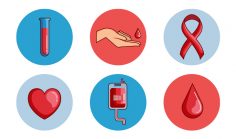These are serious conditions that involve extreme changes in eating behavior and weight regulation. Eating disorders are more common in industrialized societies where there is an abundance of food–and where being thin, especially for women, is considered attractive. Eating disorders are most common in the United States, Canada, Europe, Australia, New Zealand, and South Africa. However, the prevalence in non-Western countries is growing.
The main types of eating disorders are:
- Anorexia nervosa
- Bulimia nervosa
- Binge eating disorder
- Otherwise Specified Feeding or Eating Disorder
All of these eating disorders are associated with serious and wide-ranging psychological, physical, and social consequences. Characterized by severe concern about body weight or shape, extreme efforts to manage weight or eating habits; eating disorders are serious conditions that can have far-reaching ramifications.
These conditions often go hand-in-hand with other illnesses, like:
- Depression
- Substance abuse
- Anxiety disorders
Eating disorders are real, treatable medical conditions—but left untreated, symptoms can become life threatening, possibly leading to complications, like organ failure or death. Anorexia has the highest mortality rate of any psychiatric disorder. But with a timely diagnosis, you can receive necessary treatment and live a long, healthy life.
While these disorders affect both genders, rates among women and girls are 2.5 times higher than those for men and boys. Often emerging during puberty or young adulthood, but can in some cases develop in childhood, or later in life.
In the United States alone, 20 million women and 10 million men suffer from eating disorders at some point in their life, according to the National Eating Disorders Association, or NEDA.
Anorexia nervosa
Most people that have anorexia nervosa view themselves as overweight, even when it is apparent to the outside world that that they are actually underweight. For those that suffer from anorexia, food and weight control become obsessive fixations, and can become the center of daily life. Behavior associated with anorexia can include very careful portioning of food, eating only small quantities of specific types of food, and repeatedly weighing oneself. For some, there are bouts of binge eating that are followed by excessive exercise, extreme dieting, overuse of laxatives and/or diuretics, enemas, and self-induced vomiting.
Symptoms of anorexia nervosa may include:
- Dangerously low body weight
- Strict food restriction
- Persistent, unrelenting pursuit of thinness
- Refusal to maintain a healthy, normal weight
- Deep fear of gaining weight
- Deeply skewed perception of body image
- Low self-esteem, which is heavily impacted by misperceptions of body weight and shape
- Denial of the seriousness of low body weight
- Lack of menstruation among girls and women
The earlier treatment begins, the better the odds of recovery. Some recover with minimal treatment, while others may suffer several relapses. And some may have a more chronic form of anorexia, in which their health declines as they battle the illness.
Listed below are other possible medical complications and symptoms associated with anorexia, that may develop over time:
- Brittle hair and nails
- Dry and yellowish skin
- Growth of fine hair all over the body, known as lanugo
- Mild anemia, muscle wasting, and weakness
- Osteopenia or osteoporosis (thinning of the bones)
- Drop in internal body temperature, causing a person to feel cold all the time
- Lethargy, sluggishness, and feeling tired all the time
- Severe constipation
- Infertility
- Low blood pressure, or slowed breathing and pulse rates
- Damage to the structure and function of the heart
- Brain damage
- Multi-organ failure
Bulimia nervosa
Bulimia nervosa, or bulimia, is characterized by frequent and recurring episodes of bing eating, followed by some compensatory behavior for the overeating like self-induced vomiting, excessive use of laxatives or diuretics, excessive exercise (sometimes referred to as hypergymnasia), fasting, or a combination of these behaviors.
People that have bulimia often maintain a healthy, normal body weight; some are even slightly overweight. Similar to anorexia, there is often an intense fear of gaining weight, a strong desire to lose weight, and an intense unhappiness with body shape and size. Bulimic behavior is often done in secret as it is connected to feelings of disgust or shame. The binge eating and purging cycle can happen anywhere from several times a week to many times a day.
Other symptoms of bulimia may include:
- Chronically swollen and sore throat
- Inflamed salivary glands in the neck and jaw area
- Worn down tooth enamel, along with increasingly sensitive and decaying teeth, due to repeated exposure to stomach acid from vomiting
- Acid reflux disorder and other gastrointestinal problems
- Intestinal pain, discomfort, and possible chronic irritation from laxative abuse
- Dehydration from purging of fluids
- Electrolyte imbalance—too low or too high levels of minerals like potassium, sodium, calcium, which can—if severe enough—lead to a heart attack or stroke.
Binge eating disorder
Binge eating disorder is characterized by a loss of control over eating habits. Unlike with bulimia, periods of binge eating are not followed by purging, excessive exercise, fasting, or laxative/diuretic use—and perhaps as a result, those with binge eating disorder are often overweight, or even obese. Those with binge eating disorder have a higher risk of developing high blood pressure and other metabolic or cardiovascular diseases. There is a cyclical aspect to binge eating disorder because the guilt and shame that sufferers feel about their binge eating often leads to more binge eating as a means to make themselves feel better.
The key features of binge eating disorder are:
- Frequent episodes of uncontrollable binge eating.
- Feeling extremely distressed or upset during or after bingeing.
- Unlike bulimia, there are no regular attempts to “make up” for the binges through vomiting, fasting, or over-exercising.
Other Specified Feeding or Eating Disorder
Formerly described at Eating Disorders Not Otherwise Specified (EDNOS) in the DSM-IV (Diagnostic and Statistical Manual of Mental Disorders, the main reference guide used by medical and mental health providers to diagnose psychiatric disorders), this type of eating disorder is now known as Other Specified Feeding or Eating Disorder (OSFED) in the new DSM-V. OSFED is an eating disorder that causes significant distress or impairment, but does not meet the criteria for another eating disorder. A person with OSFED may present with many of the symptoms of other eating disorders such as anorexia, bulimia, or binge eating disorder, but does not meet the full criteria for diagnosis for any one of these particular disorders. It is important to state that this does not mean this is a less serious type of eating disorder. In fact, approximately 30% of people who seek treatment for an eating disorder have OSFED.
The following are some examples of condition presentations, which would be given a diagnosis of OSFED:
- Atypical Anorexia nervosa. Anorexic behaviors are present, but without the low body weight
- Bulimia nervosa of lower frequency than typically required to meet diagnostic criteria of bulimia nervosa
- Binge eating disorder of lower frequency than typically required to meet diagnostic criteria of binge eating disorder
- Purging disorder. Unlike with bulimia, sufferers purge without bingeing
- Night eating syndrome. Characterized by eating abnormally little food during the day, but then overeating at night













